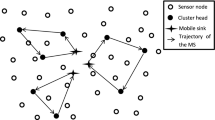Abstract
Traditional wireless sensor networks (WSNs) with one static sink node suffer from the well-known hot spot problem, that of sensor nodes near the static sink bear more traffic load than outlying nodes. Thus, the overall network lifetime is reduced due to the fact some nodes deplete their energy reserves much faster compared to the rest. Recently, adopting sink mobility has been considered as a good strategy to overcome the hot spot problem. Mobile sink(s) physically move within the network and communicate with selected nodes, such as cluster heads (CHs), to perform direct data collection through short-range communications that requires no routing. Finding an optimal mobility trajectory for the mobile sink is critical in order to achieve energy efficiency. Taking hints from nature, the ant colony optimization (ACO) algorithm has been seen as a good solution to finding an optimal traversal path. Whereas the traditional ACO algorithm will guide ants to take a small step to the next node using current information, over time they will deviate from the target. Likewise, a mobile sink may communicate with selected node for a relatively long time making the traditional ACO algorithm delays not suitable for high real-time WSNs applications. In this paper, we propose an improved ACO algorithm approach for WSNs that use mobile sinks by considering CH distances. In this research, the network is divided into several clusters and each cluster has one CH. While the distance between CHs is considered under the traditional ACO algorithm, the mobile sink node finds an optimal mobility trajectory to communicate with CHs under our improved ACO algorithm. Simulation results show that the proposed algorithm can significantly improve wireless sensor network performance compared to other routing algorithms.



Similar content being viewed by others
References
Akyildiz IF, Su W, Sankarasubramaniam Y, Cayirci E (2002) A survey on sensor networks. IEEE Commun Mag 40(8):102–114. doi:10.1109/MCOM.2002.1024422
Heinzelman W, Chandrakasan A, Balakrishnan H (2000) Energy-efficient communication protocol for wireless micro sensor networks. In: Proceedings of the 33rd IEEE Hawaii Conference on System Sciences, pp 1–10
Mottaghi S, Zahabi MR (2014) Optimizing LEACH clustering algorithm with mobile sink and rendezvous nodes. Int J Electron Commun 69(2):507–514. doi:10.1016/j.aeue.2014.10.021
Nazir B, Hasbullah H (2011) Mobile sink based routing protocol (MSRP) for prolonging network lifetime in clustered wireless sensor network. In: Proceedings of the 2010 International Conference on Computer Applications and Industrial Electronics. pp 624–629
Jafri MR, Javaid N, Javaid A, Ali Z (2013) Maximizing the lifetime of multi-chain PEGASIS using sink mobility. J World Appl Sci 21(9):1283–1289. doi:10.5829/idosi.wasj.2013.21.9.175
Lindsey S, Raghavendra CS (2002) PEGASIS: Power efficient gathering in sensor information systems. Proc IEEE Aerosp Conf 3:1125–1130
Chu WC, Ssu KF (2014) Sink discovery in location-free and mobile-sink wireless sensor networks. Comput Netw 67(5):123–140. doi:10.1016/j.comnet.2014.03.028
Sharma S, Puthal D, Jena SK et al (2016) Rendezvous based routing protocol for wireless sensor networks with mobile sink. J Supercomput 73(3):1168–1188
Wang J, Cao J, Ji S et al (2017) Energy-efficient cluster-based dynamic routes adjustment approach for wireless sensor networks with mobile sinks. J Supercomput 73(7):3277–3290
Chen M, Xu X, Zhang S, Feng G (2012) Energy efficient routing protocol in mobile-sink wireless sensor networks. Telkomnika Indonesian J Electr Eng 10(8):2056–2062. doi:10.11591/telkomnika.v10i8.1640
Shi L, Zhang B, Mouftah HT, Ma J (2012) DDRP: An efficient data-driven routing protocol for wireless sensor networks with mobile sinks. Int J Commun Syst 26(10):1341–1355. doi:10.1002/dac.2315
Wang C-F, Shih J-D, Pan B-H, Wi T-Y (2014) A network lifetime enhancement method for sink relocation and its analysis in wireless sensor networks. IEEE Sens J 14(6):1932–1943. doi:10.1109/JSEN.2014.2306429
Xie S, Wang Y (2014) Construction of tree network with limited delivery latency in homogeneous wireless sensor networks. Wirel Pers Commun 78(1):231–246. doi:10.1007/s11277-014-1748-5
Shen J, Tan H-W, Wang J, Wang J-W, Lee S-Y (2015) A novel routing protocol providing good transmission reliability in underwater sensor networks. J Intern Technol 16(1):171–178. doi:10.6138/JIT.2014.16.1.20131203e
Zhang Y, He S, Chen J (2016) Near optimal data gathering in rechargeable sensor networks with a mobile sink. IEEE Trans Mobile Comput 16(6):1718–1729
Deng R, He S, Chen J (2014) Near-optimal online algorithm for data collection by multiple sinks in wireless sensor networks. IEEE International Conference on Communications, pp 2803–2808
Zhang X, Bao H, Ye J, Yan K, Zhang H (2013) A data gathering scheme for WSN/WSAN based on partitioning algorithm and mobile sinks. In: Proceedings of the IEEE 10th International Conference on High Performance Computing and Communications & 2013 IEEE International Conference on Embedded and Ubiquitous Computing. pp 1968–1973
Liu X, Zhao H, Yang X, Li X (2013) SinkTrail: A proactive data reporting protocol for wireless sensor networks. IEEE Trans Comput 62(1):151–162. doi:10.1109/TC.2011.207
Andziulis A, Dzemydienė D, Steponavičius R, Jakovlev S (2011) Comparison of two heuristic approaches for solving the production scheduling problem. Inf Technol Control 40(2):118–122. doi:10.5755/j01.itc.40.2.426
Neumann F, Witt C (2010) Ant colony optimization and the minimum spanning tree problem. Theor Comput Sci 411(25):2406–2413. doi:10.1016/j.tcs.2010.02.012
López-Ibáñez M, Blum C (2010) Beam-ACO for the travelling salesman problem with time windows. Comput Oper Res 37(9):1570–1583. doi:10.1016/j.cor.2009.11.015
Wang J, Cao J, Li B, Lee S, Sherratt RS (2015) Bio-inspired ant colony optimization based clustering algorithm with mobile sinks for applications in consumer home automation networks. IEEE Trans Consum Electron 61(4):438–444. doi:10.1109/TCE.2015.7389797
Acknowledgements
This work was supported by the National Natural Science Foundation of China (61402234, 61672290). This work was also supported by the National Research Foundation of Korea(NRF) Grant funded by the Korea government(MSIP) (No. 2016R1A2B4011069).
Author information
Authors and Affiliations
Corresponding author
Rights and permissions
About this article
Cite this article
Wang, J., Cao, J., Sherratt, R.S. et al. An improved ant colony optimization-based approach with mobile sink for wireless sensor networks. J Supercomput 74, 6633–6645 (2018). https://doi.org/10.1007/s11227-017-2115-6
Published:
Issue Date:
DOI: https://doi.org/10.1007/s11227-017-2115-6




